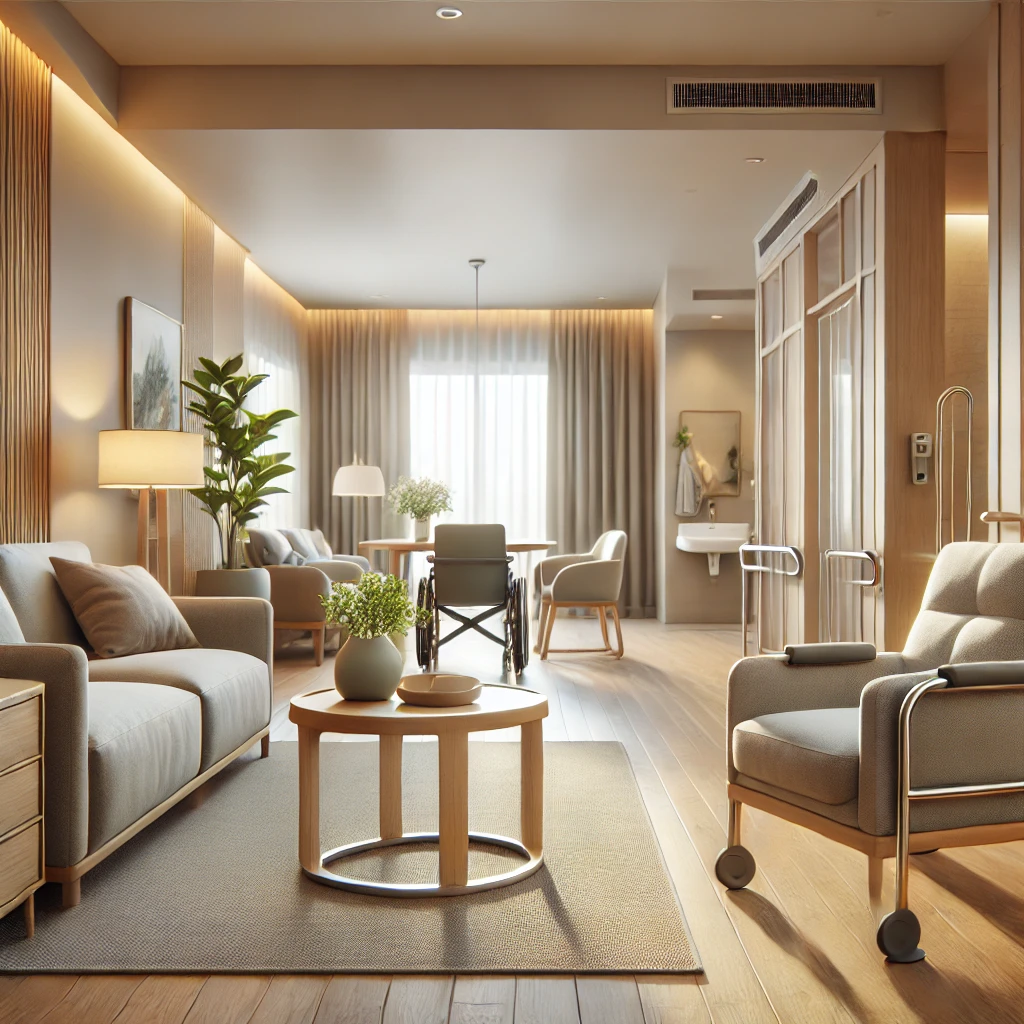As people age, the desire to remain in their own homes surrounded by familiar surroundings becomes increasingly important. “Aging in place” refers to designing spaces that allow seniors to live independently and safely in their homes for as long as possible. A detailed and thoughtful design can enhance the comfort, safety and accessibility of homes for seniors without sacrificing style or beauty. 🌟
Explore how to create senior-friendly spaces that make daily living easier, safer and more enjoyable for older adults:
1. Prioritize Safety and Accessibility🛡️🚪
The first step in designing a home for aging in place is ensuring safety and accessibility. As mobility and physical abilities change with age, the home should be designed to minimize risks and provide easy access to all areas.
– No-Step Entryways: One of the most significant accessibility features is a no-step entry. A ramp or level access makes it easier for seniors with mobility issues or who use wheelchairs or walkers to enter the home safely.
– Wider Doorways: Standard doorways can be too narrow for wheelchairs or walkers. Widening doorways to at least 36 inches ensures easy passage and accessibility throughout the home.
– Non-Slip Flooring: Slip and fall accidents are a major concern for older adults. Replace slippery flooring materials with non-slip alternatives such as vinyl, cork or textured tiles. Avoid rugs or mats that could become tripping hazards.
– Grab Bars and Handrails: In areas like the bathroom where slips are common, installing grab bars and sturdy handrails provides extra stability. Look for stylish designs that blend seamlessly with the bathroom decor to maintain an attractive aesthetic.
2. Focus on Comfort and Convenience 🛋️🛏️
Comfort is key when designing spaces for seniors. Creating environments that are easy to navigate and comfortable to live in enhances quality of life as physical needs evolve.
– Accessible Storage: Place cabinets and storage at accessible heights. Avoid high shelves or deep, hard-to-reach cabinets and opt for pull-out drawers or turn-tables in the kitchen for ease of use. This makes it simple to access everyday items without bending or reaching.
– Lever-Style Door Handles: Replacing traditional round doorknobs with lever-style handles makes opening doors much easier for seniors, especially those with arthritis or limited grip strength. These handles are stylish and functional, contributing to both design and comfort.
– Easy-to-Use Faucets: Install single-lever or touchless faucets in kitchens and bathrooms. These are far easier to use than twist knobs and can reduce strain on hands and wrists.
3. Well-Designed Lighting for Visibility and Safety💡👀
As we age, vision tends to weaken, so it’s essential to design spaces with sufficient lighting. A well-lit home improves visibility and reduces the risk of accidents, while also contributing to a welcoming and warm environment.
– Layered Lighting: Use a mix of ambient, task and accent lighting to brighten rooms evenly. Place task lighting in key areas like the kitchen, bathroom and reading areas. Pendant lights, under-cabinet lights and floor lamps can also reduce shadows and improve visibility.
– Motion-Sensor Lights: Install motion-sensor lighting in areas like hallways, bathrooms and entryways to ensure the home is well-lit even when the lights aren’t switched on. This provides added safety during nighttime trips to the bathroom or kitchen.
– Light Switch Placement: Make sure light switches are at an accessible height, around 36 inches from the floor. This makes it easy for anyone, whether standing or in a wheelchair to turn on lights.
4. Senior-Friendly Bathroom Design 🚿🛁
The bathroom is one of the most important spaces to adapt for aging in place as it can be a high-risk area for falls. Simple design adjustments can make a bathroom safe, accessible and comfortable.
– Curbless Showers: A curbless, walk-in shower with a hand-held showerhead and a built-in bench provides easier access and safety. These showers eliminate the need to step over a high tub or shower edge, reducing fall risks.
– Non-Slip Flooring and Mats: Use non-slip tiles or flooring in the bathroom and add rubberized, slip-resistant mats in areas prone to water splashes.
– Raised Toilet Seats: Installing a raised toilet seat or choosing a comfort-height toilet can make sitting and standing easier for seniors with limited mobility.
5. Functional and Stylish Furniture 🪑✨
The right furniture can support independence and comfort while ensuring the space remains stylish and inviting.
– Firm, Supportive Seating: Choose sofas and chairs with firm cushions that offer support for easy standing and sitting. Seating with arms provides added stability when getting up and higher seat heights can be helpful for seniors.
– Rounded Corners on Furniture: To avoid sharp edges and reduce the risk of injury, choose furniture with rounded corners. This small design tweak can make a big difference in preventing accidents.
– Adjustable Beds: In the bedroom, consider adjustable beds that can raise the head or legs for improved comfort and ease of use. These beds are especially helpful for those with circulation issues or mobility challenges.
6. Open and Flexible Layouts 📐🚶
Aging in place requires thoughtful space planning to ensure that the home remains navigable and flexible for changing needs.
– Open Floor Plans: Open layouts provide clear pathways for easy movement, especially for those using mobility aids. Remove unnecessary walls or obstacles that could impede movement between rooms.
– Furniture Arrangement: Keep furniture arrangements simple and avoid clutter. Ensure there is plenty of space to move freely without bumping into furniture and make sure pathways are at least 36 inches wide to accommodate wheelchairs or walkers.
Designing a senior-friendly home is about more than just adding grab bars and ramps — it’s about creating a comfortable, safe and functional environment that enhances independence and quality of life. 🏡🌿 With thoughtful design choices, such as accessible storage, well-placed lighting and supportive furniture, homes can be adapted to meet the needs of seniors while maintaining a stylish and inviting aesthetic.






